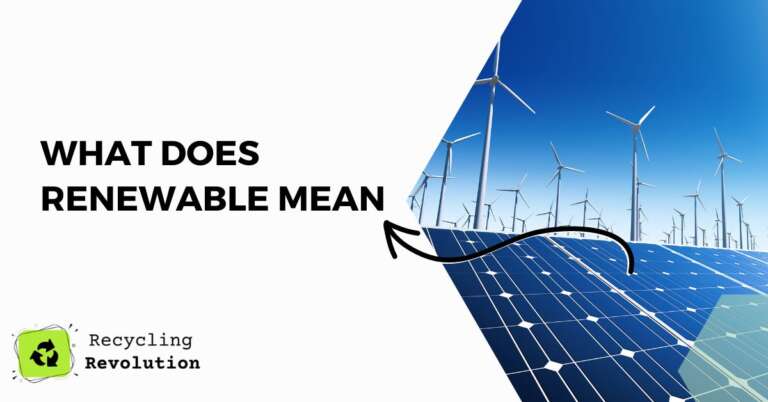If you’ve ever pondered upon the word “renewable” and wondered what lies beneath its surface, you’ve clicked on the right article. “Renewable” isn’t just another buzzword.
It’s a philosophy, a guiding principle, and, in many ways, the beacon for a sustainable future. But let’s dig deeper, shall we?
tl;dr: Renewable, in its essence, refers to resources that can be naturally replenished on a human timescale. It is the cornerstone of sustainable energy practices aimed at reducing our carbon footprint and ensuring a balanced ecosystem. Resources like wind, solar, and hydro are classic examples of renewable energy sources.
Unpacking “Renewable” Meaning
The term “renewable” stems from the Latin word ‘renovare’ which means to renew or restore. Essentially, anything termed as “renewable” can be naturally replenished, with the key distinction being the timescale.
The Timescale Matters
Non-renewable resources, such as coal or oil, take millions of years to form. They are finite and will eventually be depleted. Renewable resources, on the other hand, can regenerate within our lifetime. This difference in renewal timescale is the heart of what separates renewable from non-renewable.
The Resources That Lead the Charge
Solar energy, wind energy, and hydroelectricity are the poster children of renewable energy.
- Solar Energy: The sun’s energy is harnessed using solar panels. It’s estimated that the energy the sun provides to the Earth for one hour could meet the global energy needs for one year!
- Wind Energy: Wind turbines convert kinetic energy into electricity. And here’s a fun fact: A single wind turbine can power 500 homes.
- Hydroelectricity: Utilizes the gravitational force of falling or flowing water to generate electricity. Grand Coulee Dam, one of the largest in the U.S., can generate over 6,800 megawatts of electricity.
I recommend considering a switch to these sources if you’re looking to make a personal impact on sustainability.
The “Actions” of Going Renewable
Switching to renewable energy sources isn’t just about keeping up with trends. There’s an extensive list of benefits that come along with it:
Reducing Carbon Footprint
Non-renewable energy sources emit tons of carbon dioxide, contributing to global warming. Renewables, on the other hand, have a much smaller carbon footprint.
According to a study published in the journal Nature Energy, shifting to renewable energy could reduce the power sector’s carbon emissions by up to 80%.
Economic Boost
Contrary to popular belief, renewables aren’t just environment-friendly; they’re wallet-friendly too. Renewables have led to job creation, with the solar and wind sectors growing at a rate 12 times faster than the rest of the U.S. economy.
Energy Independence
Relying on renewable sources means less dependence on foreign oil and a more stabilized energy infrastructure.
Note: While there are challenges to overcome in the renewable sector, such as energy storage and transmission, technological advancements are steadily addressing these issues.
What’s Next for Renewables?
The future is bright and green! With technological innovations and increasing awareness, the shift towards renewables is accelerating. As the International Renewable Energy Agency (IRENA) notes, renewables could form up to 86% of global power demand by 2050. That’s a world I’d want to be part of!
I recommend actively following renewable energy advancements and considering ways to incorporate them into your daily life, whether it’s opting for a solar-powered charger or supporting businesses that prioritize renewable energy.
Beyond the Big Three: Other Renewable Sources
While solar, wind, and hydro are often the most talked about, several other renewable energy sources play a crucial role in the energy matrix:
Geothermal Energy: This energy is sourced from the heat emanating from the Earth’s core. Regions with volcanic or seismic activity, in particular, can harness this heat to generate electricity. Not only is it renewable, but it also boasts of a low carbon footprint.
Biomass and Biofuels: Biomass refers to organic materials, such as wood, agricultural residues, and even algae. When these are burned, or biologically processed, they produce energy. Biofuels, derived from biomass, can replace gasoline in our cars, heating oil in furnaces, and more.
Tidal and Wave Energy: Our oceans are not just vast expanses of water; they’re massive energy reserves. The gravitational pull of the moon causes tides, and these tidal movements, along with ocean waves, can be harnessed for energy.
Challenges in the Renewable Landscape
It’s not all sunny in the world of renewables. There are challenges that the sector grapples with:
- Intermittency and Reliability: The sun doesn’t always shine, and the wind doesn’t always blow. This intermittent nature of some renewable sources can pose challenges to consistent energy supply.
- Storage Solutions: Given the above challenge, energy storage solutions, like batteries, are vital. While there are advancements in this area, scalable and affordable storage solutions are still a work in progress.
- Initial Costs: The initial investment for renewable infrastructure, such as solar panels or wind turbines, can be high. However, it’s worth noting that these costs have been steadily decreasing and the long-term savings often outweigh the initial costs.
Note: Embracing renewables doesn’t mean overlooking these challenges. Instead, being aware can help us advocate for more research and solutions.
The Global Embrace of Renewables
Across continents and cultures, the transition to renewable energy sources is being recognized not just as a necessity for environmental conservation but also as a catalyst for economic growth.
The renewable revolution resonates with a universal truth: the future of energy is sustainable, and it’s in our hands.
Leading the Pack: Setting Standards and Pioneering Innovations
Germany’s energy transformation, termed “Energiewende,” has positioned the nation as a global leader in renewable energy.
According to the Fraunhofer Institute for Solar Energy Systems, solar and wind power sometimes account for 40-60% of electricity generation in Germany, especially during peak periods.
China, on the other hand, has been investing heavily in solar photovoltaic technology. As per the International Energy Agency (IEA), China is the world’s largest producer of solar panels and accounted for nearly 60% of global solar PV installations in 2017.
Denmark’s commitment to wind energy is noteworthy. A report from Energinet, Denmark’s transmission systems operator, revealed that wind power generated 47% of the country’s electricity consumption in 2019, highlighting the potential of consistent investment and innovation in renewables.
Emerging Economies: Venturing into the Green Frontier
India, with its vast landscape and abundant sunlight, has seen significant growth in solar installations. The National Institute of Solar Energy estimates India’s solar potential to be about 750 GW. By 2022, the Indian government aims to achieve an ambitious 175 GW of renewable energy capacity.
Brazil, meanwhile, has tapped into its vast natural resources, focusing on bioenergy and hydropower. According to the Brazilian Ministry of Mines and Energy, about 44% of the country’s energy comes from renewables, a proportion much higher than the global average.
International Collaboration: The Strength of Unity
Recognizing the power of collective effort, the International Solar Alliance (ISA) was launched at the UN Climate Change Conference in Paris in 2015.
With an aim to harness solar energy more efficiently, the ISA seeks to aggregate demand for solar technologies, foster collaboration, and share best practices among member nations.
Such collective endeavors allow countries, especially those with limited resources, to tap into a pool of shared knowledge and technology.
The Intersection of Technology and Renewables
The dynamic confluence of technology and renewable energy sources has revolutionized the way we produce, consume, and think about energy. From harnessing sun and wind power more efficiently to smartly distributing this energy to our homes, technological innovations have catalyzed the green energy revolution.
Smart Grids
Traditional power grids are often limited in their ability to manage fluctuating power sources. However, with the integration of Artificial Intelligence (AI) and machine learning, modern smart grids have transformed the energy distribution paradigm.
According to the U.S. Department of Energy, smart grids use digital communication technology to detect and react to local changes in usage, ensuring optimal energy distribution.
For renewable sources, which can be intermittent – the sun doesn’t always shine, and the wind doesn’t always blow – smart grids are a game-changer. For instance, during peak solar energy production, any excess energy can be fed back into the grid and redistributed where needed. Such an approach not only ensures efficient energy use but also minimizes waste.
Enhanced Energy Efficiency
As per the International Energy Agency (IEA), advancements in technology have led to a significant reduction in energy consumption by modern appliances. For instance, LED lights consume up to 85% less energy than traditional incandescents. Similarly, advanced refrigerators, washing machines, and air conditioners designed with the latest tech use far less energy than their predecessors.
When combined with energy sourced from renewables, this reduced consumption means that even a smaller quantum of green energy can suffice the needs of a household or a business, making the entire system more sustainable.
Tech Giants Taking the Lead
It’s no longer enough for tech companies to be pioneers in software or hardware alone. The pivot towards sustainability is evident. According to Google’s 2019 Environmental Report, the company matched 100% of its global electricity consumption with renewable energy. Apple, in its 2020 Environmental Progress Report, announced its plans to be entirely carbon neutral by 2030. These commitments are backed by investments in large-scale renewable projects, including solar farms and wind energy plants.
Such initiatives by tech behemoths not only reflect their commitment to a sustainable future but also set a precedent for other businesses worldwide. Their involvement in the renewable sector not only aids in reducing their carbon footprint but also drives innovation, as they deploy their resources and technological expertise in this domain.
I recommend always opting for energy-efficient appliances and supporting tech companies in their green endeavors.
In wrapping up this extended deep dive, it’s evident that “renewable” isn’t a mere term; it’s a multifaceted world brimming with potential, challenges, innovations, and global collaborations. It’s a clarion call for all of us to act, innovate, and sustain.
Conclusion
So, what does “renewable” mean? It’s a beacon for a future where we coexist with nature, ensure resources for generations to come, and take a stance against ecological degradation. Renewable is not just a term; it’s a responsibility, a commitment, and most importantly, a path forward.
FAQ
What is the difference between renewable and sustainable?
While both terms focus on long-term ecological balance, “renewable” primarily refers to energy that can be replenished in a human timescale. “Sustainable” is a broader term, focusing on meeting our needs without compromising the future generations’ ability to meet theirs.
Are all renewable energies also clean energies?
Mostly, yes. Renewable energies generally have a much smaller carbon footprint compared to non-renewables. However, some aspects, like the manufacturing of solar panels, can have environmental impacts, but they are significantly lesser than those of non-renewable energies.
How can I switch to renewable energy sources?
Start with small steps. Opt for green energy plans from your utility provider, invest in solar panels for your home, or support businesses and products that prioritize renewables. Remember, every bit counts!
Till next time, let’s renew our commitment to a greener planet, shall we?

